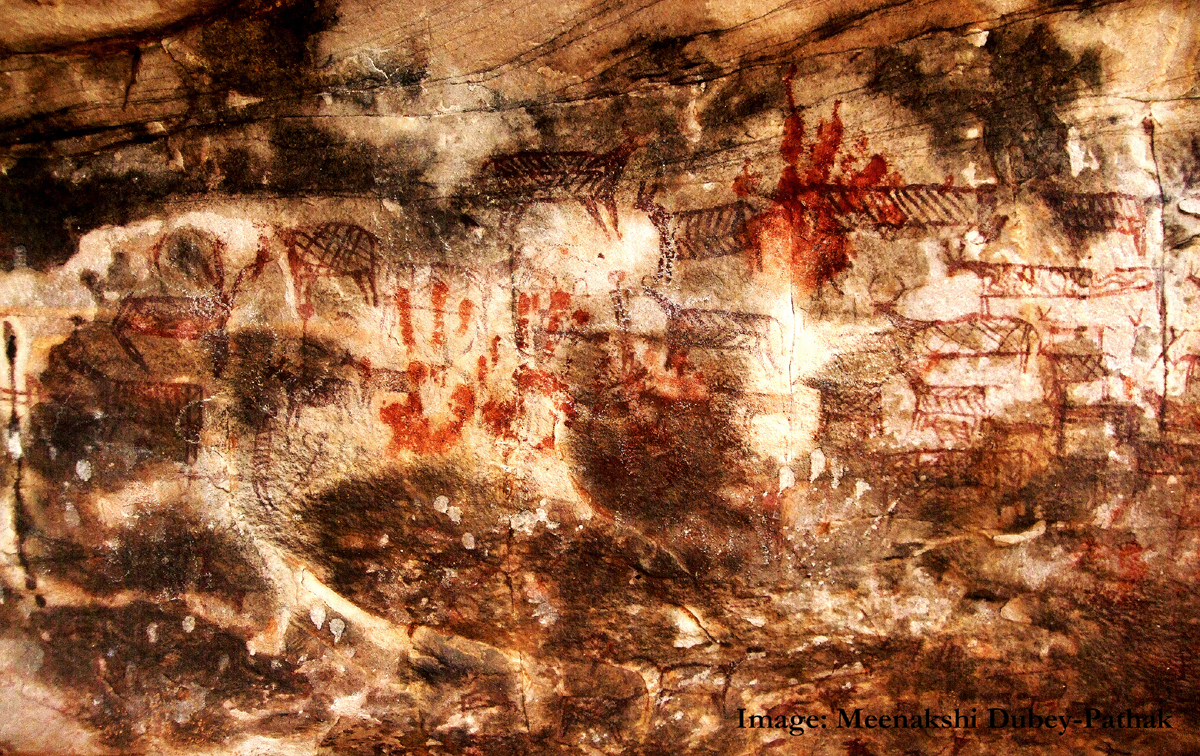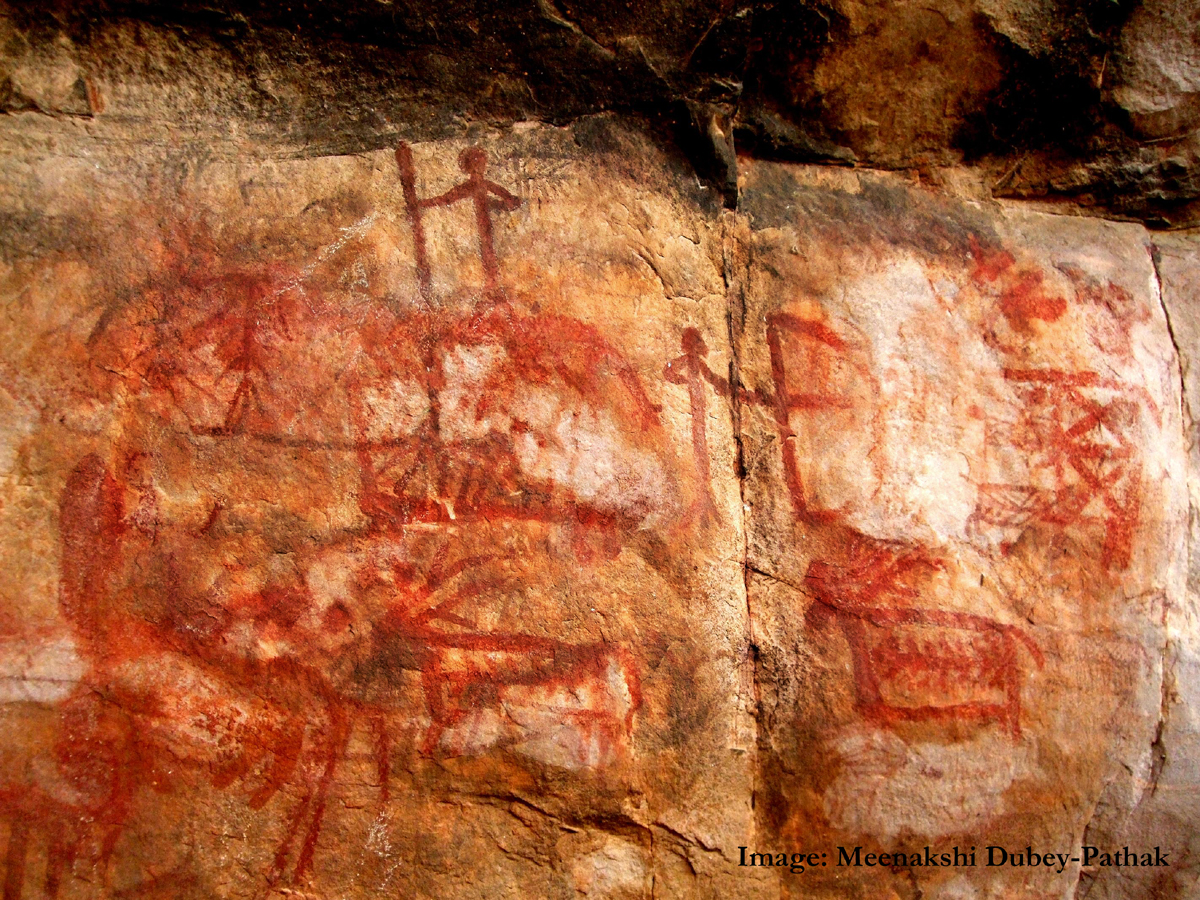


Painted Shelters of Dharkundi in Central India
Follow Dr Meenakshi Dubey Pathak as she discusses some of her memorable rock art sites discovered and documented in India.

In 2012, the discovery of the Dharkundi rock art site was an interesting one. I was invited to join a school picnic in the Dharkundi forest, located at the border of two Indian states, Madhya Pradesh and Uttar Pradesh.
I accepted the invitation with the hope of looking for some rock art sites in the Vindhyan region.

Firstly, we went to a temple cum Ashram (a hermitage for Hindu sadhus or holy men). There I saw a big open shelter with a large overhang which was, with little more construction, converted into an Ashram. I walked around the area analyzing the local landscape. I asked the head Sadhu (monk) if he had seen any rock art in this vicinity; he answered that he had. But they didn't know who had made the rock art nor the purpose behind making the art. They also told me that out of curiosity to know more about the colors, they had tried to rub and wash the rock paintings with coconut jute and water (to my horror!), but to their surprise (and my relief!) the colors were still intact. I was aghast after listening to them. Then I explained to them about the history, the importance and the value of rock art. On my request they showed me further rock art sites.
Painted Shelters of Dharkundi in Central #India #RockArt #archaeology https://t.co/YtHEV8IK1P pic.twitter.com/54z8O7PZTh
— Bradshaw Foundation (@BradshawFND) August 8, 2016
The rock art sites are situated near the dense forest of the Ashram area, within a 3 to 5kms trek. We found Jogini Ki Gupha- (jogini means holy woman) 1-2A-2B-3-4. The shelters were with large overhangs, and named by the locals Gupha (cave).Thick banyan aerial roots had covered parts of the walls of almost every shelter. I explored, along with my daughter Shreyasi Pathak, 5 rock art sites with the help of Sadhu from the Dharmkundi Ashram.
The subjects of the art were mainly deer, sambhar, blackbucks, swamp deer, bear, tiger, humped bison, elephant, small goat-like animals, dogs and peacocks. Humans figures were depicted with hourglass and stick shape bodies, as dancers, archers, hunters and horse riders. There were images of honeycombs hanging on the branches of trees. There were also some Buddhist symbols like the lotus and kalash (small vassal or pot) and many handprints. These are superimposed on the early paintings.
Meenakshi Dubey Pathak
Images: Meenakshi Dubey Pathak - 'Newly Discovered Rock Paintings of Dharkundi', International newsletter INORA, no.66 (IBAN-FR7613135000800810229531780), France (pg no.10-19).In 2013.
Visit the India Rock Art Archive:
http://www.bradshawfoundation.com/india/index.php
by Bradshaw Foundation
Monday 30 May 2022
by Bradshaw Foundation
Wednesday 19 January 2022
by Bradshaw Foundation
Thursday 06 January 2022
by Bradshaw Foundation
Monday 06 December 2021
by Bradshaw Foundation
Monday 29 November 2021
by Bradshaw Foundation
Monday 25 October 2021
by Bradshaw Foundation
Monday 12 July 2021
by Bradshaw Foundation
Monday 24 May 2021
by Bradshaw Foundation
Tuesday 20 April 2021
by Bradshaw Foundation
Thursday 01 April 2021
by Bradshaw Foundation
Tuesday 23 February 2021
by Bradshaw Foundation
Thursday 14 January 2021
by Bradshaw Foundation
Friday 18 December 2020
by Bradshaw Foundation
Sunday 06 December 2020
by Bradshaw Foundation
Thursday 26 November 2020
by Bradshaw Foundation
Wednesday 07 October 2020
by Bradshaw Foundation
Monday 30 May 2022
by Bradshaw Foundation
Wednesday 19 January 2022
by Bradshaw Foundation
Thursday 06 January 2022
by Bradshaw Foundation
Monday 06 December 2021
by Bradshaw Foundation
Monday 29 November 2021
by Bradshaw Foundation
Monday 25 October 2021
by Bradshaw Foundation
Monday 12 July 2021
by Bradshaw Foundation
Monday 24 May 2021
by Bradshaw Foundation
Tuesday 20 April 2021
by Bradshaw Foundation
Thursday 01 April 2021
by Bradshaw Foundation
Tuesday 23 February 2021
by Bradshaw Foundation
Thursday 14 January 2021
by Bradshaw Foundation
Friday 18 December 2020
by Bradshaw Foundation
Sunday 06 December 2020
by Bradshaw Foundation
Thursday 26 November 2020
by Bradshaw Foundation
Wednesday 07 October 2020
Friend of the Foundation











